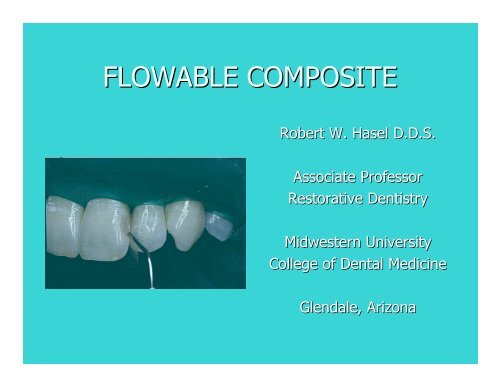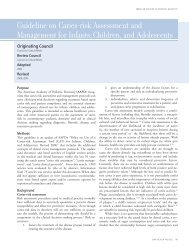FLOWABLE COMPOSITE
FLOWABLE COMPOSITE
FLOWABLE COMPOSITE
You also want an ePaper? Increase the reach of your titles
YUMPU automatically turns print PDFs into web optimized ePapers that Google loves.
<strong>FLOWABLE</strong> <strong>COMPOSITE</strong><br />
Robert W. Hasel D.D.S.<br />
Associate Professor<br />
Restorative Dentistry<br />
Midwestern University<br />
College of Dental Medicine<br />
Glendale, Arizona
1956<br />
1960’s<br />
Composite History<br />
Dr. R.L. Bowen<br />
‘bis-GMA’<br />
“Adaptic”<br />
1970’s Microfilled composite<br />
Light-initiated composite<br />
1980’s<br />
Posterior composite<br />
1990’s Hybrid composite<br />
Flowable, packable, etc.<br />
2000’s Nanocomposite<br />
Non-shrink composite ?
Resin Composites & derived<br />
�� Development<br />
materials<br />
Development<br />
�� Dissatisfaction with silicates/acrylics<br />
�� Development of ‘Bowen Bowen’s s resin’ resin – Bis-GMA Bis-GMA<br />
�� Introduction of first materials – two paste systems<br />
�� Developments in filler content<br />
�� Smaller particles<br />
��<br />
�� Microfine particles<br />
Command setting – UV cure<br />
�� Single paste – VLC<br />
�� Change in viscosity – flowable/packable<br />
�� Nanocomposites? Nanocomposites?<br />
Low shrinkage materials?
TECHNOLOGY
Alter the Paradigm
Dental composite<br />
Silane coupling<br />
agent<br />
Review<br />
Resin matrix<br />
Ceramic fillers
Fillers<br />
• Type<br />
• Size<br />
SiO 2 , barium glass, ZrO 2<br />
macrofills (>10 µm); midifills (1-10 µm)<br />
minifills (0.1-1 µm); microfills (0.04-0.1 µm);<br />
nanofills (0.02-0.07 µm)<br />
• Content<br />
40% - 80 + % by weight<br />
Variations<br />
Note : vol % is 15-20 % lower
Fillers<br />
Z100, Z250, Palfique<br />
(3M ESPE) (Tokuyama)<br />
Zirconia/silica<br />
• sol-gel process<br />
• spherical<br />
• polishability<br />
• continuum in sizes<br />
high packing density<br />
(85 wt %)
Resin matrix<br />
(light-activated composite)<br />
Monomer : bis-GMA , bis-EMA, UDMA<br />
Diluent : TEGDMA<br />
Photoinitiator : camphorquinone<br />
Co-initiator : tertiary amine<br />
Review<br />
Dimethacrylate
CQ<br />
C=C<br />
C=C<br />
C=C<br />
Activated<br />
state<br />
C=C<br />
C=C<br />
C=C<br />
Amine coinitiator<br />
+<br />
C=C<br />
C=C<br />
C=C<br />
Free<br />
radical<br />
C=C<br />
C=C<br />
C=C<br />
C=C<br />
Reaction<br />
C=C<br />
O 2<br />
C=C<br />
C=C<br />
Dimethacrylate monomer
Polymerization shrinkage<br />
Current systems : 2-3 % vol shrinkage<br />
• Methacrylate-based monomers<br />
• Free radical, addition polymerization<br />
Products in development : ‘no shrinkage’<br />
• Ring-opening reaction<br />
expand<br />
Resin matrix
O 2 inhibition layer<br />
= uncured monomer film at the surface<br />
• film thickness ~ 10 µm<br />
• not biocompatible should be removed<br />
• ? between increments ?<br />
Biocompatibility<br />
‘Most monomers have some biologic activity<br />
………but … biocompatible when reacted<br />
into polymer…’<br />
Resin matrix
Recommendations<br />
• Well cured<br />
• Remove O 2 inhibition layer<br />
• Avoid contact with uncured resin<br />
Resin matrix<br />
• 5% of dental personel have contact allergy to methacrylates<br />
• Protective gloves are inadequate Wallenhammar et al, 2000<br />
• Estrogenic effect Olea et al, 1996<br />
• Adverse reaction: asthma, blister, rashes Hallstrom, 1993<br />
• Oral lichenoid lesions Lind, 1998
<strong>FLOWABLE</strong> <strong>COMPOSITE</strong>
Problems with Paste Composite<br />
�� Difficult to use<br />
�� Difficult to manipulate<br />
�� Sticky, pull back<br />
�� Voids<br />
�� Porosities<br />
�� Unpolymerized areas<br />
�� Shrinkage<br />
�� Surface and Marginal<br />
integrity
Problems with Paste Composite<br />
�� Difficult to use<br />
�� Difficult to manipulate<br />
�� Sticky, pull back<br />
�� Voids<br />
�� Porosities<br />
�� Unpolymerized areas<br />
�� Shrinkage<br />
�� Surface and Marginal<br />
integrity<br />
�� Easy<br />
�� Easy<br />
�� Stays put<br />
�� Eliminates<br />
�� Eliminates<br />
�� Less<br />
�� Minimizes (technique)<br />
�� Best
Definition<br />
�� Definition<br />
Rheology<br />
�� Rheology is the study of the<br />
flow and deformation of matter<br />
�� Dental Dental importance importance<br />
�� Important for any material placed in the<br />
mouth in a fluid state – examples:<br />
�� Impression materials<br />
�� Directly-placed tooth restorative materials
Rheology of Resin Composites<br />
VERY WIDE RANGE OF MATERIALS<br />
SEALANTS<br />
MICROFILL<br />
<strong>FLOWABLE</strong><br />
HYBRID &<br />
RELATED MATERIALS<br />
PACKABLE or<br />
CONDENSABLE<br />
INCREASING VISCOSITY
A has highest<br />
viscosity<br />
C is the most<br />
fluid<br />
B is interintermediate Viscosity<br />
A B C
HIGH<br />
FLUIDITY<br />
LOW<br />
VISCOSITY<br />
LOW<br />
FLUIDITY<br />
dkjdfjkl<br />
HIGH<br />
VISCOSITY
Rheology of Resin Composites<br />
�� General idea - lower filler content - usually hybrid filler.<br />
Includes fumed silica, claimed to give thixotropy*<br />
�� Original claims (patent literature) - recommended for<br />
Class I, II, III, IV and V cavities<br />
�� Now being recommended for many applications (e.g.<br />
fissure sealing – discussed later)<br />
�� *What is thixotropy?<br />
thixotropy
Rheology of Resin Composites<br />
�� Thixotropy is a reversible structural breakdown of a<br />
material that occurs when the material is stressed<br />
�� Flowable composites were designed to be<br />
thixotropic<br />
�� This means that when the material is being syringed, the<br />
high stress from syringing breaks down some of the<br />
structure (e.g. hydrogen bonding), so the material flows<br />
�� But when the material is placed into the cavity, it will not<br />
flow (‘non-drip ( non-drip’) ) because the hydrogen bonding structure<br />
quickly recovers
APPARENT VISCOSITY<br />
[Pa.s]<br />
302<br />
300<br />
298<br />
296<br />
294<br />
292<br />
290<br />
Flowable Composites<br />
THERE ARE SIGNIFICANT ‘FLOW’ PROPERTY<br />
DIFFERENCES BETWEEN DIFFERENT PRODUCTS<br />
HENRY SCHEIN <strong>FLOWABLE</strong><br />
0 0.1 0.2 0.3 0.4 0.5<br />
SHEAR RATE [1/s]<br />
VERY FLUID;<br />
VIRTUALLY<br />
NEWTONIAN:<br />
NO<br />
“THIXOTROPY”<br />
-- contrast with ....
APPARENT VISCOSITY<br />
[Pa.s]<br />
Flowable Composites<br />
THERE ARE SIGNIFICANT ‘FLOW’ PROPERTY<br />
DIFFERENCES BETWEEN DIFFERENT PRODUCTS<br />
4000<br />
3500<br />
3000<br />
2500<br />
2000<br />
1500<br />
1000<br />
500<br />
0<br />
REVOLUTION<br />
0 0.2 0.4 0.6 0.8 1 1.2<br />
SHEAR RATE [1/s]<br />
…contrast<br />
HIGHER<br />
VISCOSITY;<br />
SHOWS<br />
“SHEAR<br />
THINNING”<br />
DIFFERENT<br />
TECHNIQUE<br />
AND<br />
APPLICATIONS?
Flowable Composites<br />
THERE ARE SIGNIFANT COMPOSITIONAL<br />
DIFFERENCES BETWEEN DIFFERENT PRODUCTS<br />
Material Filler content<br />
(mass %)<br />
Henry Schein 41<br />
Starflow 61<br />
Revolution 60<br />
Florestore 50
Flowable Composites<br />
�� SOME MATERIALS (at least 34!) – examples -<br />
�� Florestore (Den-Mat)<br />
�� Flowable composite<br />
(Henry Schein)<br />
�� Revolution – Formula<br />
2 (Kerr)<br />
�� Starflow<br />
(Danville Materials)
Flowable Composites<br />
�� There is no such thing as a standard<br />
flowable material<br />
�� 34 brands (some identical); many with<br />
different formulations, handling<br />
characteristics, properties and applications<br />
�� Confusion because of untested materials -<br />
no track record of clinical success
1. Philosophy<br />
�� 1. Dental materials do not naturally belong in the mouth!<br />
�� 2. All synthetic materials evoke a host response<br />
�� 3. Synthetic materials not as good as health tooth<br />
substance<br />
�� 4. Best treatment is the least treatment<br />
�� 5. Best treatment is the most durable treatment<br />
THEREFORE – there is an obligation to prevent dental<br />
disease, and where treatment is necessary, to choose<br />
the best materials, and manipulate them in such a way<br />
that optimum properties are obtained.
Principles of Selection<br />
�� (i) Evidence from laboratory data<br />
�� (ii) Clinical performance<br />
�� (iii) Esthetic considerations<br />
�� (iv) Clinical needs<br />
�� (v) Patient’s Patient s preferences<br />
�� (vi) Operator’s Operator s preferences<br />
�� (vii) Cost effectiveness<br />
�� (viii) Environmental considerations
] higher shrinkage<br />
] compromised mechanical properties<br />
Wear (µm)<br />
Flowable composites<br />
Filler contents have<br />
Caught up<br />
28 28 26<br />
21 22<br />
flowable hybrid<br />
Fracture toughness<br />
Filler content (wt %)<br />
56<br />
68<br />
53<br />
75 80<br />
flowable hybrid<br />
1.36 1.24<br />
2.05 1.90<br />
flowable hybrid
Conclusion<br />
�� The criteria for choice of a material include<br />
not only factors such as physical and<br />
mechanical properties, but also include<br />
ease of manipulation.<br />
�� Note that there are no standard<br />
specifications for these materials, and that<br />
they differ considerably in their flow<br />
properties.
B<br />
I<br />
C<br />
M<br />
E<br />
P<br />
Need improvements?<br />
Biocompatibility<br />
Interfacial properties<br />
Chemical properties<br />
Mechanical & physical properties<br />
Esthetic consideration<br />
Practical questions<br />
cured vs uncured<br />
adhesive system<br />
Biodegradation<br />
C=C<br />
esterase<br />
C-O<br />
O<br />
& Polishability<br />
Flowable / Packable
�� Biofilm<br />
�� Improper Etching<br />
�� Thick Layers<br />
�� Unpolymerized areas<br />
�� Porosities<br />
�� Voids in the body<br />
�� Marginal Integrity<br />
�� Surface Integrity<br />
�� Shrinkage<br />
Failure Zone
�� Biofilm<br />
�� Improper Etching<br />
�� Improper Curing<br />
�� Thick Layers<br />
�� Unpolymerized areas<br />
�� Porosities<br />
FAILURE ZONE<br />
�� Voids in the body<br />
�� Marginal Integrity<br />
�� Surface Integrity<br />
�� Shrinkage











